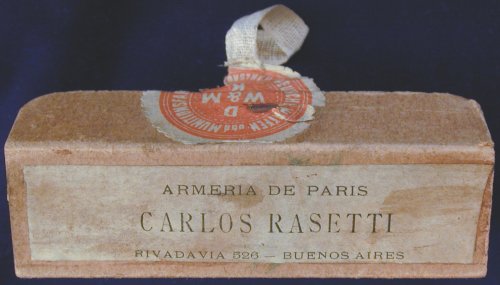The Commercial Parabellum in Argentina

Very early production new model, sn25210, commercial luger.
 Home page
Home page
At the peak of pre-WW1 DWM Luger commercial production, the Americas, particularly the United States, was one of the largest importers for the Luger with South America being the second largest importer. The demand was sufficient for DWM to publish an incredibly early 1902 Spanish language version of the instruction manual, in addition to the German, English and French versions. Argentina in particular was enamored of anything European and the DWM manufactured Luger was no exception. Many of the items discussed in this article came out of Argentina. Spain had its own munitions industry and as such was not a major importer of DWM Lugers or munitions as these manuals and other items have mostly been located in South America.
The South American demand for Luger ammunition, Cal 9mm in particular, extended into the 1930s. The demand was great enough for the newly 1936 reconstituted DWM, Deutsch Waffen- u. Munitionsfabriken A.- G. to manufacture Spanish labeled 9mm ammunition, first in Karlsruhe and later in Berlin-Borsigwalde. Four boxes of this 1930s Spanish language labeled Parabellum ammunition were obtained from Buenos Aires, Argentina. The 9mm Luger pistol was never used in any quantity in South America save for perhaps a few hundred for the Bolivian Luger. Therefore, it has been suggested that the demand for this particular Spanish labeled 9mm ammunition was used for the Bergmann sub machine gun models MP/18-I and MP/28 II in the 1930s during the Gran Chaco War. This war was between Bolivia and Paraguay.
DWM Luger 7,65mm ammunition was also supplied or sold to South America prior to WWI. One known South American importer was Carlos Rasetti, based in Buenos Aires, Argentina at 526 Rivadavia. DWM 7,65mm ammunition with Carlos Rasetti labels affixed have been located, some dated as early as 1906. There is one known 9000 serial number range old model 30 cal Luger with a hand engraved Carlos Rasetti name and address. Another lesser known importer was Juan Canedo, also of Buenos Aires. Interestingly, J. Canedo marked guns survive, such as the early production new model luger, sn25210, shown at the top of the page, the old model luger, sn 21306, with a hand engraving and a Fosbery, sn 38 shown below. The old model luger and the Fosbery are of the G. Sturgess collection.
 Old model luger, sn 21306.
Old model luger, sn 21306. Fosbery, sn 38.
Fosbery, sn 38.The firm of Carlos Rasetti was located in Buenos Aires at 526 Rivadavia from the mid 19th century (founded 1857) through the 1930s. Rassetti was not a small time operation as there was a French Rasetti factory as shown in a rare 1931 Rasetti catalog. The Carlos Rasetti label found on boxes of ammunition, DWM and other German manufacturers state they were imported through their French factory “ARMERIA DE PARIS” as early as 1906. It has been reported that Carlos Rasetti closed its doors in the early 1960s.
The J. Canedo label translates or can be interpreted as: Casa Canedo is the store front dealing in armaments and knives with the controlling company and/or manufacturer Gottling and Busch also operating in Bs Aires. Gottling and Busch is a local firm but it could have a parent company in Europe or it could have a similar factory in Europe.
The trail of the Rasetti label DWM ammo starts with:
